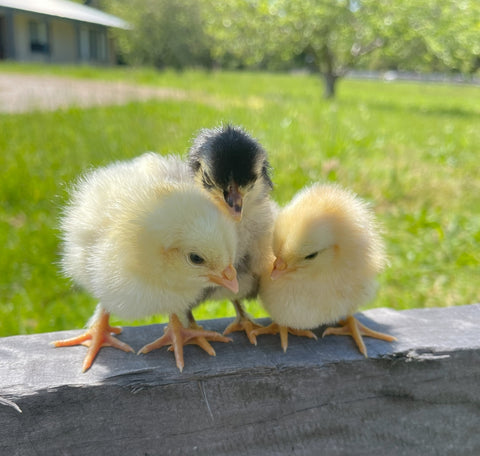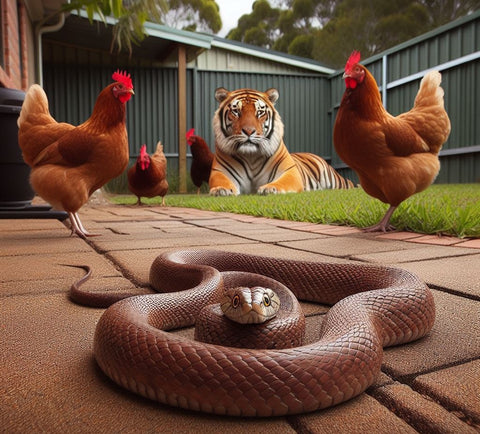It’s a fact that chickens don’t sweat (unlike us humans), so once temperatures rise above 26 degrees Celcius, chickens can experience heat stress. Moreover, heat waves can induce heatstroke and prove lethal.
The good news is that if you prepare for hot conditions and recognise the signs of heat stress in your backyard chickens, you can potentially save lives.
How do chickens cool themselves down?
Instead of sweating to lose body heat on hot days, chickens regulate their temperature by panting (it’s their clever evaporative cooling system). They also hold out their wings to enable better airflow over them to remove heat, just like your car's radiator.
Further to that, a chicken’s blood is cooled via the unique, fleshy appendages on their cheeks and head. These appendages are called combs and wattles and now you know why they’re red! Plus, chickens (unsurprisingly), drink more water to help reduce their body heat.
This works well until the heat notches up to the extreme. That’s because their core temperature already sits high at around 41 degrees Celsius and the air temperature becomes too hot to lower it.
This is when they’ll need your help. Consider these six factors:
1. Is your chicken coop big enough?
To begin with, chickens need a minimum of one square metre each in their run area (all year round). In hot weather, this is imperative because crowded conditions hinder a hen's ability to control her body temperature. Start putting some plans in place to extend their chicken coop or run if you think your chickens need more room over the summer.
2. Make sure there’s enough shade
For those who planted creepers around their chicken coop last year, your chickens will now be reaping the rewards. For those that didn’t, a quick fix is to use shade cloth. It can be easily attached to most chicken coops and runs and is quite effective in keeping out heat yet allowing good air circulation.
Sometimes, creating temporary shelters using what’s handy in the garden can do the trick too, so long as they provide shade and remain sturdy in the wind. Naturally, plenty of shrubs and trees in the range for chickens to seek shelter under are important as well.
3. Extra insulation goes a long way
Temporarily add insulation to the roof of the coop using straw bales or ply as an added protection from the baking sun. Permanent insulation underneath the roof is also a good idea but make sure that it won’t allow rodents to set-up a home in it.
4. Why ventilation is important
Chickens depend on airflow to lower their body temperature so ventilation in summer is critical. Hot air rises so ideally, coop ventilation needs to be closer to the roof near the apex. In addition, keep your coop door or any windows open on a warm night (only if it’s predator-proof!), to help increase airflow. Slatted or mesh coop floors work well to allow manure to fall to the ground to be composted in wood shavings while providing excellent ventilation for the hens.
5. Top up dust baths
The ritual of dust bathing aerates the feathers thus exposing the skin, which in turn cools the body temperature of your hens. A well-shaded dust bath with a good parasite powder will stay cool and provide extra relief on hot days along with removing external parasites.
6. Keep the hose handy
Indeed, chickens will benefit from the occasional light mist shower in a heatwave (so long as they have time to dry off before nightfall). They won’t tend to appreciate being showered but will benefit from the evaporation. Never wet your hens or their environment on calm days when humidity levels are up as they won’t be able to lose body heat nearly as efficiently.
How to reduce the impacts of heat stress
Believe it or not, it’s inevitable for chickens to experience some level of heat stress in summer because they’re better adapted to colder conditions. To understand how best you can help, firstly, it’s important to distinguish heat stress from heatstroke.
What is heat stress?
These normal physiological responses indicate heat stress:
- Panting
- Wings held away from the body
- Diarrhoea (as a result of excess water consumption)
- Reduced movement around the coop and range area
- Fewer eggs
What is heat stroke?
Heatstroke sets in when a chicken experiences heavy panting and is listless or having seizures. Without emergency intervention, a chicken will die quickly from heat stroke.
How to reduce the impacts of heat stress
Hydration, hydration, hydration.
Crucially, chickens need fresh, cool water in abundance in order to stay hydrated. They tend to avoid drinking warm water so place ice cubes/blocks in your chicken drinker to encourage them to keep up their fluids on hot days.
Another way to keep them hydrated is with frozen treats on a scrap tray. Start loading the freezer now with chunks of fruit in water. Or, freeze whole lettuce or cucumbers.
Stock up on melons – watermelon and rockmelon have high water content so make the perfect snacks when frozen.
If there’s been a run of hot days, go a step further in your efforts to rehydrate the girls. To do this, pre-purchase electrolytes (or search for a recipe), then add this into their drinking water (being careful to follow any health advice).
What if a chicken has been struck down with heatstroke?
Thankfully, your loving care to combat the impacts of heat stress will likely prevent progression to heatstroke. However, on days of extreme temperatures, a chicken may still succumb and the only way to save her life is to intervene.
- Relocate her to a cool space (preferably inside your house where you can monitor her condition)
- Submerge her (up to the neck) in cool (but not icy cold), water for a minute or so and then towel her dry
- Hydrate her as best you can (using a syringe and electrolytes if handy)
- Continue to monitor her inside until she regains energy and shows signs of wanting to return to the coop
Seek veterinary advice if in any doubt.







Comments (0)
There are no comments for this article. Be the first one to leave a message!